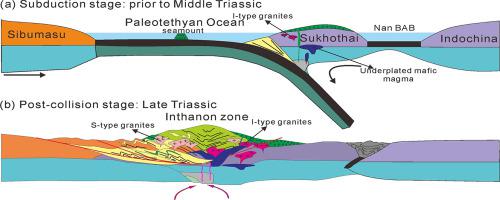当前位置:
X-MOL 学术
›
Gondwana Res.
›
论文详情
Our official English website, www.x-mol.net, welcomes your feedback! (Note: you will need to create a separate account there.)
Late Triassic post-collisional granites related to Paleotethyan evolution in northwestern Lao PDR: Geochronological and geochemical evidence
Gondwana Research ( IF 6.1 ) Pub Date : 2020-08-01 , DOI: 10.1016/j.gr.2020.03.002 Xin Qian , Yuejun Wang , Yuzhi Zhang , Yukun Wang , Vongpaseuth Senebouttalath
Gondwana Research ( IF 6.1 ) Pub Date : 2020-08-01 , DOI: 10.1016/j.gr.2020.03.002 Xin Qian , Yuejun Wang , Yuzhi Zhang , Yukun Wang , Vongpaseuth Senebouttalath

|
Abstract The late Paleozoic to early Mesozoic granites exposed in northwestern Lao PDR provide important constraints on the tectonic evolution of the Eastern Paleotethyan Ocean and regional correlation with the giant granitic belt in Southeast Asia. New geochronological data show that the granites have Late Triassic zircon U–Pb ages of 231–220 Ma. They are dominated by monzogranite and biotite granite with an I-type geochemical affinity. These granites are enriched in LREEs and LILEs and depleted in HFSEs. The geochemical variations for these granites indicate the fractional crystallization of plagioclase, K-feldspar, biotite, apatite, and Fe–Ti oxides. Their initial 87Sr/86Sr ratios range from 0.7021 to 0.7105 and eNd (t) values from −1.6 to −7.3. Zircon in-situ eHf (t) values are in range of −6.0–+5.3 (peaks at −2.8 and +2.5, respectively), Hf model ages of 0.67–1.64 Ga (peaks at 0.83 Ga and 1.45 Ga, respectively), and δ18O values of 6.6‰–8.0‰, similar to the Late Triassic granitoids from the Eastern Province in Southeast Asia. These granites originated from a mixed source of ancient metamorphic rocks with juvenile mafic crust. The Late Triassic granites in northwestern Lao PDR formed in a post-collisional setting in response to the thickened crustal collapse during the assembly of the Sibumasu with Indochina blocks. These granites can southerly link with the Eastern granite province of the Eastern Paleotethyan Domain in Southeast Asia.
中文翻译:

与老挝西北部古特提斯演化相关的晚三叠世后碰撞花岗岩:年代学和地球化学证据
摘要 老挝西北部出露的晚古生代至早中生代花岗岩对东古特提斯洋的构造演化以及与东南亚巨型花岗岩带的区域对比提供了重要制约。新的年代学数据表明,这些花岗岩的晚三叠世锆石 U-Pb 年龄为 231-220 Ma。它们以二长花岗岩和黑云母花岗岩为主,具有I型地球化学亲和力。这些花岗岩富含 LREE 和 LILE,而缺乏 HFSE。这些花岗岩的地球化学变化表明斜长石、钾长石、黑云母、磷灰石和铁钛氧化物的分异结晶。它们的初始 87Sr/86Sr 比率范围为 0.7021 至 0.7105,eNd (t) 值范围为 -1.6 至 -7.3。锆石原位 eHf (t) 值在 -6.0–+5.3 范围内(分别在 -2.8 和 +2.5 处出现峰值),Hf 模型年龄为 0.67-1.64 Ga(峰值分别为 0.83 Ga 和 1.45 Ga),δ18O 值为 6.6‰-8.0‰,与东南亚东部省份晚三叠世花岗岩相似。这些花岗岩起源于古老变质岩与新生基性地壳的混合来源。老挝西北部的晚三叠世花岗岩形成于碰撞后环境,以响应 Sibumasu 与印度支那地块组装期间加厚的地壳坍塌。这些花岗岩可以向南与东南亚东古特提斯域的东部花岗岩省相连。这些花岗岩起源于古老变质岩与新生基性地壳的混合来源。老挝西北部的晚三叠世花岗岩形成于碰撞后环境,以响应 Sibumasu 与印度支那地块组装期间加厚的地壳坍塌。这些花岗岩可以向南与东南亚东古特提斯域的东部花岗岩省相连。这些花岗岩起源于古老变质岩与新生基性地壳的混合来源。老挝西北部的晚三叠世花岗岩形成于碰撞后环境,以响应 Sibumasu 与印度支那地块组装期间加厚的地壳坍塌。这些花岗岩可以向南与东南亚东古特提斯域的东部花岗岩省相连。
更新日期:2020-08-01
中文翻译:

与老挝西北部古特提斯演化相关的晚三叠世后碰撞花岗岩:年代学和地球化学证据
摘要 老挝西北部出露的晚古生代至早中生代花岗岩对东古特提斯洋的构造演化以及与东南亚巨型花岗岩带的区域对比提供了重要制约。新的年代学数据表明,这些花岗岩的晚三叠世锆石 U-Pb 年龄为 231-220 Ma。它们以二长花岗岩和黑云母花岗岩为主,具有I型地球化学亲和力。这些花岗岩富含 LREE 和 LILE,而缺乏 HFSE。这些花岗岩的地球化学变化表明斜长石、钾长石、黑云母、磷灰石和铁钛氧化物的分异结晶。它们的初始 87Sr/86Sr 比率范围为 0.7021 至 0.7105,eNd (t) 值范围为 -1.6 至 -7.3。锆石原位 eHf (t) 值在 -6.0–+5.3 范围内(分别在 -2.8 和 +2.5 处出现峰值),Hf 模型年龄为 0.67-1.64 Ga(峰值分别为 0.83 Ga 和 1.45 Ga),δ18O 值为 6.6‰-8.0‰,与东南亚东部省份晚三叠世花岗岩相似。这些花岗岩起源于古老变质岩与新生基性地壳的混合来源。老挝西北部的晚三叠世花岗岩形成于碰撞后环境,以响应 Sibumasu 与印度支那地块组装期间加厚的地壳坍塌。这些花岗岩可以向南与东南亚东古特提斯域的东部花岗岩省相连。这些花岗岩起源于古老变质岩与新生基性地壳的混合来源。老挝西北部的晚三叠世花岗岩形成于碰撞后环境,以响应 Sibumasu 与印度支那地块组装期间加厚的地壳坍塌。这些花岗岩可以向南与东南亚东古特提斯域的东部花岗岩省相连。这些花岗岩起源于古老变质岩与新生基性地壳的混合来源。老挝西北部的晚三叠世花岗岩形成于碰撞后环境,以响应 Sibumasu 与印度支那地块组装期间加厚的地壳坍塌。这些花岗岩可以向南与东南亚东古特提斯域的东部花岗岩省相连。


























 京公网安备 11010802027423号
京公网安备 11010802027423号